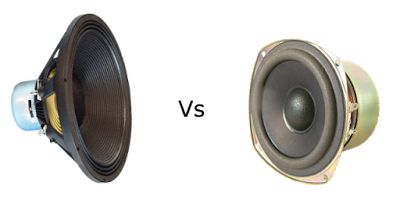7 different types of music systems that exist: Sound systems by category
Music is a gift to life on all earth. A tweeting bird, breeze, rainfall, waterfalls etc are all relaxing and pleasing to listen.
However the same music needs a quality speaker system to reproduce it without sound coloration.
An improperly tuned speaker might actually cause hearing fatigue instead of having a relaxing effect (people who has more experience using sound equalisers know this).
This is why one has to choose a sound system carefully.
Sound systems can be classified as
1. Midrange only systems
2. Midrange with bass systems (sometimes called fullrange)
3. High definition sound systems
1. Midrange speakers
Midrange speakers produce only vocal frequencies and frequencies produced by certain musical instruments. Midrange can be a good choice for listening to casual music and lectures.
2. Midrange with bass (sometimes called fullrange)
This type is less common and are usually costlier. They require more power to handle low frequencies. They sound warm and full, but lack effects. Sounds from these speakers can be heard, but not felt.
3. What is High definition sound?
High definition means, a combination of subbass, bass, midrange and highs. Usually bass and midrange has the lot of information whereas subbass and high frequencies emphasis the sound effects. (example : brusting crackers, earthquake etc all lie in subbass range. The sound of waterfalls, breaking glass etc lie in the high frequency range.)
Such high definition sound systems are available in the market as two way, three way or multi way systems.
4. Two way speakers
These speakers usually have a tweeter and a bass driver. They are often called bookshelf speakers. They do produce a good sound stage and can be combined with a subwoofer. Two way speakers are a best choice for medium budget.
5. Three way speakers
They do have a bass driver, mid range and tweeter. They have several design considerations. Improper selection of drivers and crossover frequencies might make it more vulnerable to distortion and nonlinear responses. Hence two way speakers would be a better choice if there is no prior knowledge about sound systems.
6. Dipole and Bipole speakers
Dipole and bipole speakers have two or more speakers in the same enclosure. They are usually used as surround speakers that are wired in different polarities. Better to avoid if there is no prior knowledge about acoustics.
7. Multichannel surround speakers
Multiple speakers are good for creating a virtual surround sound. The sound quality of these systems depend on the choice of subwoofer and main speakers.
Budget subwoofers, usually have difficulty blending with main speakers. A good quality subwoofer with good crossover selection and good selection of main speaker driver makes the system perform better.
Budget subwoofers, usually have difficulty blending with main speakers. A good quality subwoofer with good crossover selection and good selection of main speaker driver makes the system perform better.
A carefully tuned midrange or full range or a two way system would be a better choice than a improperly designed 2.1 or 5.1 system.
Features vs sound quality:
Todays market see a vast number of systems with lot of features say usb, fm, bluetooth etc. A feature rich sound system may or may not sound good to the ears. So it is wise to buy seperately the sound system and the feature pack say for example a Blueray dvd player with usb, fm, bluetooth etc from a good brand and individual speaker system from the same brand or speaker system from another good brand.
Low cost multimedia systems
The competitive market sees a vast number of feature rich products which makes the task of selecting a sound system to be a tedious one. There are a number of systems either 2.1 or 5.1 that may be good for gaming and movies, but not good for a full and rich music. The reason might be the sound from the woofer does not blend well with the midrange or have musical imbalance say more bass and weak midrange that makes the sound boomy.
In case of midrange only or full range speakers improper tuning might affect the performance. The sound might cause hearing fatigue or the transient response could be bad.


Comments
Post a Comment